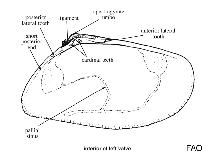Donax obesulus Reeve, 1854
Google image | No image available for this species;
drawing shows typical species in Donacidae.
Classification / Names Common names | Synonyms | CoL | ITIS | WoRMS
Bivalvia | Cardiida | Donacidae
Environment: milieu / climate zone / depth range / distribution range Ecology
Benthic. Tropical
Distribution Countries | FAO areas | Ecosystems | Occurrences | Introductions
Pacific South America.
Length at first maturity / Size / Weight / Age
Maturity: Lm ? range ? - ? cm
Life cycle and mating behavior Maturity | Reproduction | Spawning | Eggs | Fecundity | Larvae
Main reference
References | Coordinator | Collaborators
Thatje, S., O. Heilmayer and J. Laudien 2008 Climate variability and El Niño Southern Oscillation: implications for natural coastal resources management. Helgol Mar Res 62(Suppl1):S5-S14. (Ref. 92479)
IUCN Red List Status
(Ref. 130435: Version 2025-1)
CITES status (Ref. 108899)
CMS (Ref. 116361)
Threat to humans
Human uses
| FishSource |
Tools
More information
Diet composition
Food consumption
Predators
Max. ages / sizes
Length-weight rel.
Length-length rel.
Length-frequencies
Mass conversion
Abundance
FAO areas
Ecosystems
Occurrences
Introductions
Internet sources
BHL | BOLD Systems | CISTI | DiscoverLife | FAO(Publication : search) | Fishipedia | GenBank (genome, nucleotide) | GloBI | Gomexsi | Google Books | Google Scholar | Google | PubMed | Tree of Life | Wikipedia (Go, Search) | Zoological Record



